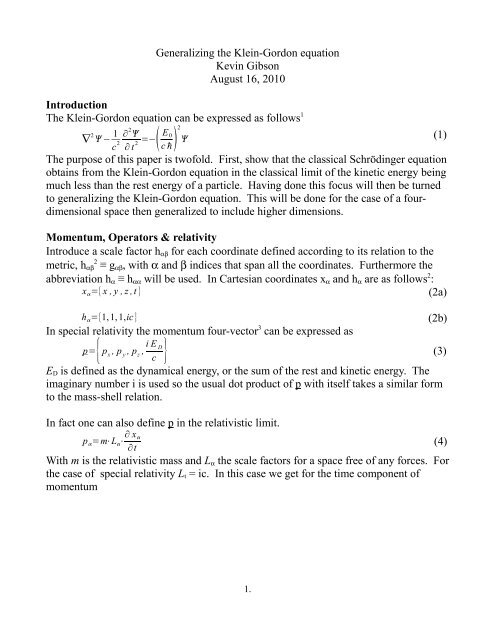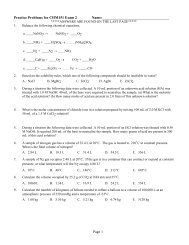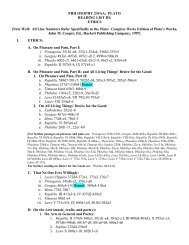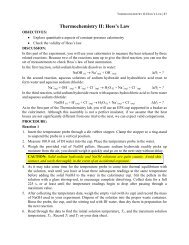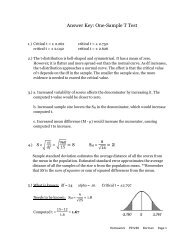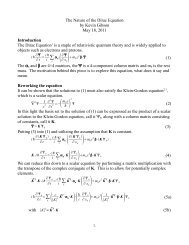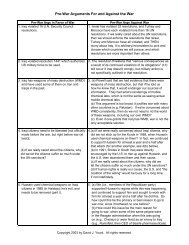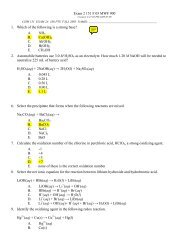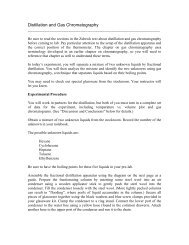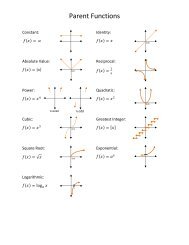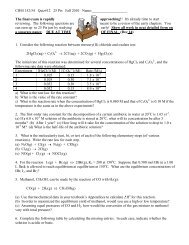Generalizing the Klein-Gordon equation
Generalizing the Klein-Gordon equation
Generalizing the Klein-Gordon equation
Create successful ePaper yourself
Turn your PDF publications into a flip-book with our unique Google optimized e-Paper software.
<strong>Generalizing</strong> <strong>the</strong> <strong>Klein</strong>-<strong>Gordon</strong> <strong>equation</strong>Kevin GibsonAugust 16, 2010IntroductionThe <strong>Klein</strong>-<strong>Gordon</strong> <strong>equation</strong> can be expressed as follows 1∇ 2 − 1 ∂ 2 c 2 ∂ t =− E 0 (1)2The purpose of this paper is twofold. First, show that <strong>the</strong> classical Schrödinger <strong>equation</strong>obtains from <strong>the</strong> <strong>Klein</strong>-<strong>Gordon</strong> <strong>equation</strong> in <strong>the</strong> classical limit of <strong>the</strong> kinetic energy beingmuch less than <strong>the</strong> rest energy of a particle. Having done this focus will <strong>the</strong>n be turnedto generalizing <strong>the</strong> <strong>Klein</strong>-<strong>Gordon</strong> <strong>equation</strong>. This will be done for <strong>the</strong> case of a fourdimensionalspace <strong>the</strong>n generalized to include higher dimensions.c ħ2Momentum, Operators & relativityIntroduce a scale factor h αβ for each coordinate defined according to its relation to <strong>the</strong>metric, h 2 αβ ≡ g αβ , with α and β indices that span all <strong>the</strong> coordinates. Fur<strong>the</strong>rmore <strong>the</strong>abbreviation h α ≡ h αα will be used. In Cartesian coordinates x α and h α are as follows 2 :x ={x , y , z ,t }(2a)h ={1, 1, 1,ic}(2b)In special relativity <strong>the</strong> momentum four-vector 3 can be expressed asp={ p , p , p , i E Dx y zc } (3)E D is defined as <strong>the</strong> dynamical energy, or <strong>the</strong> sum of <strong>the</strong> rest and kinetic energy. Theimaginary number i is used so <strong>the</strong> usual dot product of p with itself takes a similar formto <strong>the</strong> mass-shell relation.In fact one can also define p in <strong>the</strong> relativistic limit.p =m⋅L ⋅ ∂ x (4)∂tWith m is <strong>the</strong> relativistic mass and L α <strong>the</strong> scale factors for a space free of any forces. For<strong>the</strong> case of special relativity L t = ic. In this case we get for <strong>the</strong> time component ofmomentum1.
p t=m⋅i c= E Dc ⋅i c=i⋅E D2 cConnecting <strong>the</strong> <strong>Klein</strong>-<strong>Gordon</strong> <strong>equation</strong> to <strong>the</strong> Schrödinger EquationThis section will prove that <strong>the</strong> <strong>Klein</strong>-<strong>Gordon</strong> <strong>equation</strong> above becomes <strong>the</strong> Schrödinger<strong>equation</strong> for a free particle under <strong>the</strong> condition that <strong>the</strong> dynamical energy isapproximately equal to <strong>the</strong> rest energy. For now assume a four-dimensional Minkowskispace.The <strong>Klein</strong>-<strong>Gordon</strong> <strong>equation</strong> can be reworked as follows− ħ2⋅∇2m 2 ħ 22 i ħ⋅∂ =i ħ⋅∂∂ t ∂ t2E 0 ⋅∂2 ∂ t 2 E 0With E 0 = m rest·c 2 . It can be shown above that a fixed energy is possible under <strong>the</strong>condition.i ħ⋅ ∂ ∂t =E D (6)In <strong>the</strong> classical limit E D ≈ E 0 and soi ħ⋅ ∂ ∂t ≈ E 0∂∂ t ≈ E 0i ħ (7)Under this approximation <strong>the</strong> <strong>Klein</strong> <strong>Gordon</strong> <strong>equation</strong> simplifies to(8)− ħ22 m ⋅∇ 2 E 0=i ħ⋅ ∂∂tThis is <strong>the</strong> Schrödinger <strong>equation</strong> with <strong>the</strong> rest energy included. By comparison with <strong>the</strong>classical conservation of energy <strong>the</strong> total energy (kinetic plus rest plus potential energy)E is represented by <strong>the</strong> portion on <strong>the</strong> right side. It is <strong>the</strong>refore postulated that <strong>the</strong> totalenergy operator E will always be simplyE op =i ħ⋅ ∂ ∂t (9)so <strong>the</strong> relativistic quantum mechanical <strong>equation</strong>s go to <strong>the</strong> Schroedinger <strong>equation</strong> in <strong>the</strong>classical limit.<strong>Generalizing</strong> <strong>the</strong> <strong>Klein</strong>-<strong>Gordon</strong> EquationThe Laplacian for <strong>the</strong> space described by <strong>the</strong> scale factors in (2b) is 4□ 0 2 = ∂2 ∂ x 2 ∂2 ∂ y 2 ∂2 ∂ z 2 − 1 c 2⋅∂2 ∂ t 2 (10)(5)2.
Again, <strong>the</strong> zero subscript denotes a special relativistic coordinate system where noforces are present.In this light <strong>the</strong> <strong>Klein</strong>-<strong>Gordon</strong> <strong>equation</strong> above can be rewritten as□ 2 0=− E 20cħ (11)Which suggests a generalization of <strong>the</strong> <strong>Klein</strong>-<strong>Gordon</strong> <strong>equation</strong> as follows□ =− 2 E 20cħ (12)However as we allow for higher dimensions this will not reduce down to <strong>the</strong> original<strong>Klein</strong>-<strong>Gordon</strong> <strong>equation</strong> for <strong>the</strong> case of a particle in a free space. To correct for this <strong>the</strong>generalized <strong>Klein</strong>-<strong>Gordon</strong> <strong>equation</strong> can be modified as follows□ [ 2 ∇ 2 0− 1 ∂ 2 c 2 ∂ t ] =− E 202 cħ □ 2 0 (13)With <strong>the</strong> del operator involving only <strong>the</strong> three spatial coordinates and <strong>the</strong> L denoting that<strong>the</strong> geometry of a free space is to be used.Black HolesThe above will lastly be applied to <strong>the</strong> case of black holes. Here <strong>the</strong> geometry of spacetimeis given by <strong>the</strong> Schwarzchild metric 5 .ds 2 =dr21− R sR1− sr r⋅d 2 r sin ⋅d 2 −c⋅t ⋅ 2r (14)R s is <strong>the</strong> Schwarzchild radius. The non-zero scale factors obtained from <strong>the</strong>Schwarzchild metric along with <strong>the</strong> product of all factors are as followsh r1R1−srh θrh φr⋅sin h tΠi c⋅ 1− R sri c r 2 ⋅sin 3.
Using (13) we can obtain <strong>the</strong> <strong>Klein</strong>-<strong>Gordon</strong> <strong>equation</strong> for black holes.1r 2⋅ ∂∂ r { r 2 −r⋅R S } ∂∂ r 1 r ∂ ⋅ ∂ ∂sin ∂ { 1r sin } ∂2 ∂ r 2c 2 ⋅r−R S ⋅∂2 ∂t =− E 20 2 c ħ(15)One important thing to note is <strong>the</strong> time derivative term will blow up at R s unless <strong>the</strong> timederivative goes to zero. Thus a wave packet moving into a black hole must freeze up at<strong>the</strong> Schwarzchild radius, consistent with general relativistic considerations for objectsfalling into a Black Hole.ConclusionsThe <strong>Klein</strong>-<strong>Gordon</strong> <strong>equation</strong> and uncertainty principle can easily be generalized toaccommodate whatever space a particle may be in. However, it must be noted that thispaper does not address how to include particle-particle interactions in a relativisticmanner.Works Cited1. http://en.wikipedia.org/wiki/<strong>Klein</strong>-<strong>Gordon</strong>_<strong>equation</strong>2. Kevin Gibson Space-time Math (unpublished)www.mc.maricopa.edu/~kevinlg/i256/Relativity_Math.pdf3. John J. Brehm and William J. Mullin Introduction to <strong>the</strong> structure of Matter p. 634. Herbert Goldstein Classical Mechanics 2 nd ed. p. 3035. http://en.wikipedia.org/wiki/Schwarzschild_metricContact informationkevin.gibson@asu.edukevinlg@mesacc.edu4.


